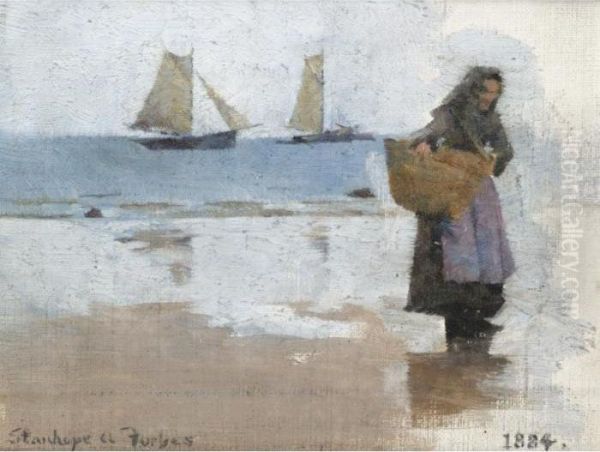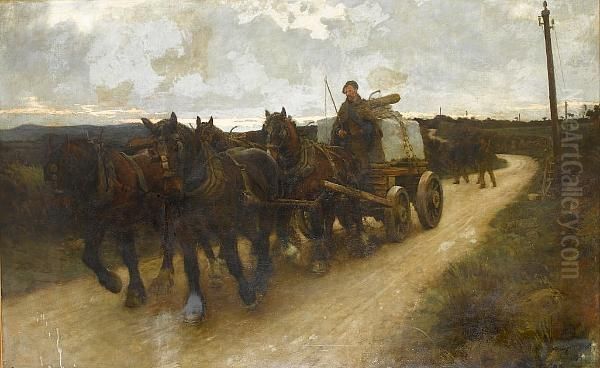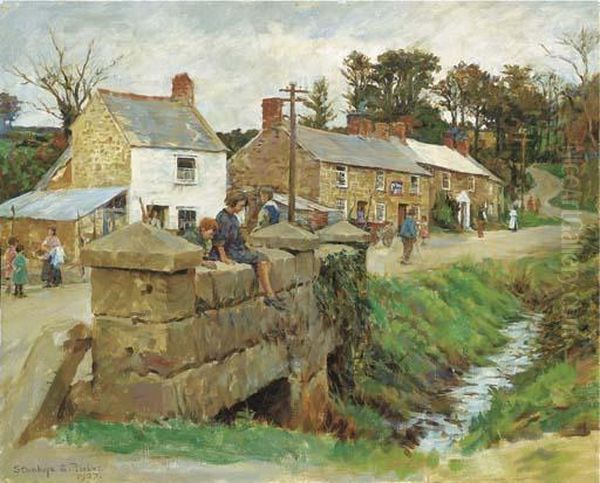
Stanhope Alexander Forbes stands as a pivotal figure in late nineteenth and early twentieth-century British art. Born in Dublin, Ireland, in 1857, he became a naturalised British subject and is celebrated primarily as a foundational member and leading light of the Newlyn School, an art colony based in Cornwall. His dedication to painting en plein air (outdoors) and his realistic, yet deeply sympathetic, depictions of everyday life, particularly the labours and community of fisherfolk and rural workers, cemented his reputation and left an indelible mark on the British art scene. His career spanned a period of significant artistic change, and he navigated these shifts while remaining true to his core principles of observation and authenticity.
Early Life and Artistic Formation
Stanhope Forbes's journey into the art world began with formal training, initially attending the Lambeth School of Art in London. His foundational education continued at the prestigious Royal Academy Schools in London, where he studied between 1874 and 1875. This grounding in academic tradition provided him with essential technical skills, but his artistic vision would soon be shaped by more contemporary European influences. Like many aspiring artists of his generation, Forbes looked towards France for further inspiration and training, a move that proved crucial in defining his mature style.
His time spent training in Paris under Léon Bonnat exposed him to the currents of French Realism. However, it was his experiences painting in Brittany during the early 1880s, particularly alongside fellow artist Henry Herbert La Thangue, that were truly transformative. There, he encountered the work and principles of French Naturalist painters, most notably Jules Bastien-Lepage. Bastien-Lepage's emphasis on rural subjects, objective yet sensitive portrayal, and use of a high tonal range and square brush technique resonated deeply with Forbes and many of his contemporaries.

The French practice of painting en plein air was perhaps the most significant influence Forbes absorbed during this period. The commitment to working directly from nature, capturing the fleeting effects of light and atmosphere, became central to his artistic philosophy. He believed this method imparted a unique "freshness" and truthfulness to painting that could not be achieved solely through studio work. This dedication to outdoor painting would become a hallmark of his career and a defining characteristic of the Newlyn School he would later help establish.
The Move to Newlyn and the Founding of a School
In 1884, seeking new subjects and perhaps inspired by the burgeoning trend of artists' colonies, Stanhope Forbes moved to the small fishing village of Newlyn, located on the coast of Cornwall in the far southwest of England. He was drawn by the unique quality of the light, the picturesque harbour, the rugged coastal scenery, and, crucially, the lives of the local fishing community. Newlyn offered a wealth of authentic, unidealised subject matter that perfectly suited his developing Realist and Naturalist inclinations.
Forbes was not alone in recognising Newlyn's potential. He quickly became a central figure in a growing community of artists who were similarly attracted to the area and shared a commitment to plein air painting and contemporary realism. This group, which included figures like Frank Bramley, Walter Langley, Norman Garstin, Thomas Cooper Gotch, and Henry Scott Tuke, coalesced into what became known as the Newlyn School. Forbes, with his strong artistic vision and organisational abilities, naturally emerged as a leader within this burgeoning movement.
The Newlyn School artists formed a close-knit community, sharing studios, models, and ideas. They engaged in mutual criticism and learning, fostering an environment of artistic growth and shared purpose. Their focus was firmly on depicting the local environment and its inhabitants with honesty and accuracy, often focusing on scenes of daily labour, domestic life, and communal events within the fishing village. They largely eschewed overtly sentimental or anecdotal Victorian narrative painting in favour of a more direct, observational approach influenced by French models but adapted to a distinctly British context.
Artistic Style, Themes, and Techniques
Stanhope Forbes's art is characterised by its commitment to realism and naturalism, deeply informed by his plein air practice. He aimed to capture the world as he saw it, paying meticulous attention to the details of everyday life, the specific conditions of light and weather, and the authentic appearance of his subjects. His work often focused on the fishing community of Newlyn and the surrounding rural landscapes of Cornwall. He depicted fishermen preparing their boats, women mending nets or awaiting the return of the fleet, market scenes on the beach, and agricultural labourers at work.

A profound sympathy and respect for the working people he depicted permeates his canvases. While objective in his observation, Forbes imbued his scenes with a sense of dignity and quiet heroism, highlighting the resilience and communal spirit of those whose lives were often harsh and demanding. He avoided romanticisation, instead finding significance in the mundane realities of labour and daily existence. This focus on the working class aligned him with broader European Realist trends, exemplified by artists like Jean-François Millet, though Forbes's approach was generally less overtly political and more focused on specific observation.
Technically, Forbes was a master of capturing natural light. His plein air method allowed him to study the subtle shifts in colour and tone under different atmospheric conditions. His palette, particularly in his earlier Newlyn works, often featured silvery greys, blues, and muted earth tones, reflecting the specific coastal light of Cornwall. He employed a relatively square brushstroke, influenced by Bastien-Lepage, which contributed to the sense of immediacy and textural accuracy in his paintings. While influenced by Impressionism's focus on light and outdoor work, Forbes maintained a greater commitment to solid form and detailed representation than many of his French Impressionist counterparts like Claude Monet or Camille Pissarro.
Major Works and Recognition
Forbes achieved significant public recognition relatively early in his Newlyn period. His painting A Fish Sale on a Cornish Beach, exhibited at the Royal Academy in 1885, was a resounding success. This large, complex canvas depicted the bustling activity of fishermen and buyers on the shore, showcasing Forbes's skill in handling a multi-figure composition, capturing diverse textures and the specific atmosphere of the scene under an overcast sky. Its critical and popular acclaim helped solidify Forbes's reputation and brought national attention to the Newlyn School. The success of this work reportedly caused some competitive pressure among his peers but undeniably established the Newlyn style in the public eye.
Another highly celebrated work is The Health of the Bride, exhibited in 1889 and subsequently purchased for the Tate collection. This interior scene depicts a wedding celebration in a fisherman's cottage, notable for its sensitive portrayal of community ritual, its masterful handling of indoor light filtering through the window, and its detailed rendering of the figures and setting. It exemplifies Forbes's ability to combine careful observation with nuanced human emotion.

Other significant works further demonstrate the range of his subject matter and his consistent artistic concerns. The Quarry Team (date uncertain, likely 1890s) tackles a scene of heavy industrial labour, depicting men and horses hauling stone, again showcasing his interest in the dignity of work. The Old Bridge (1900) reveals his understanding of light effects and rural tranquility, while later works like Fit Out at Mousehole Harbour (1919) show his continued engagement with the maritime life of Cornwall. During World War I, Forbes served as an official war artist, producing works such as WRNS Rating Sail-making (1918), a realistic depiction of women contributing to the war effort in the Devonport Dockyard.
His contributions to British art were formally recognised through his election as an Associate of the Royal Academy (ARA) in 1892, followed by his elevation to full Royal Academician (RA) status in 1910. These accolades confirmed his position within the mainstream British art establishment, even as he remained geographically based in Cornwall.
Marriage, Collaboration, and Later Life
In 1889, Stanhope Forbes married Elizabeth Adela Armstrong, a talented Canadian-born artist who had also been drawn to Newlyn. Elizabeth Forbes was a significant painter, printmaker, and watercolourist in her own right, sharing her husband's interest in local subjects but often bringing a lighter touch and a focus on women and children to her work. Their marriage represented both a personal and artistic partnership.
Together, Stanhope and Elizabeth Forbes became central figures in the Newlyn art community. In 1899, they co-founded the Newlyn School of Painting, formalising the teaching that had already been taking place informally. The school attracted numerous students to the area, further invigorating the local art scene and contributing to the village's economy, which had suffered from declines in the fishing industry. They provided instruction based on the principles of plein air painting and direct observation that defined the Newlyn ethos.
Their life together, however, was marked by personal tragedy. Elizabeth Forbes died relatively young in 1912, a significant blow to Stanhope both personally and professionally. Further sorrow followed with the death of their only son, Alec, who was killed in action during the First World War. Despite these profound losses, Forbes continued to paint and remained an active figure in the art world.
In his later career, some observers noted a loosening of Forbes's style, perhaps moving away slightly from the tighter naturalism of his earlier work. While he remained committed to representational painting, his brushwork occasionally became broader. He continued to exhibit regularly and maintained his position as the elder statesman of the Newlyn art scene. He also played a role in local arts infrastructure, having been instrumental in the establishment of the Newlyn Art Gallery in 1895, which provided a dedicated exhibition space for the local artists.
Legacy and Influence

Stanhope Forbes passed away in Newlyn in 1947 at the age of 89, having spent the majority of his long and productive career in the Cornish village he helped make famous. His legacy is substantial and multifaceted. As a principal founder and the most prominent figure of the Newlyn School, he played a crucial role in establishing one of the most significant regional art movements in late Victorian and Edwardian Britain. The school popularised plein air painting and realist subject matter, offering a distinctly British alternative to French Impressionism while absorbing key lessons from continental naturalism.
Forbes's influence extended through his own widely exhibited and collected works, which brought the lives of Cornish fisherfolk and rural labourers to national attention. His paintings are held in major public collections across the UK, including the Tate, the Royal Academy, and numerous regional galleries, ensuring their continued visibility. His sympathetic yet unsentimental portrayal of working-class life contributed to a broader shift in artistic subject matter during the period.
Furthermore, his role as a teacher, particularly through the Newlyn School of Painting co-founded with Elizabeth Forbes, directly shaped the next generation of artists. He helped disseminate the principles of plein air painting and observational realism to numerous students. Contemporaries like George Clausen, while developing his own distinct style of rural realism, shared Forbes's interest in agricultural life and the influence of Bastien-Lepage. While vastly different in style, even major international figures like John Singer Sargent were part of the same broad artistic milieu in which Forbes operated and gained recognition.
Stanhope Forbes remains a key figure for understanding the development of British art at the turn of the twentieth century. He successfully synthesized continental influences with a distinctly British sensibility, creating a body of work that documented a specific time and place with enduring skill and humanity. His dedication to painting the world around him directly from life, and his focus on the dignity of ordinary people, continue to resonate. He is rightly remembered as the "father" of the Newlyn School and a master of British plein air painting.